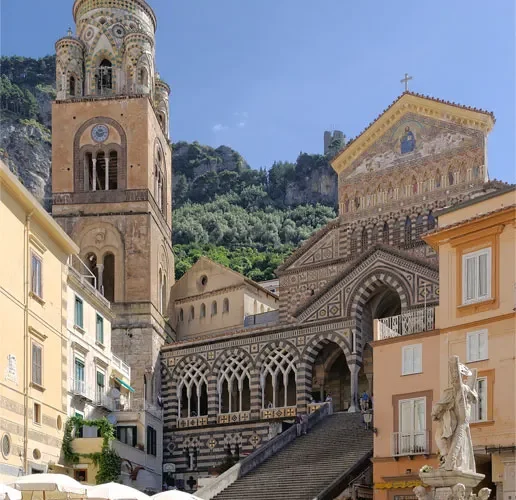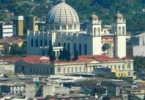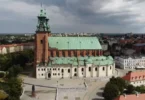
Introduction
Amalfi Cathedral (Italian: Duomo di Amalfi; Cattedrale di Sant’Andrea) is a medieval Roman Catholic cathedral in the Piazza del Duomo, Amalfi, Italy. It is dedicated to the Apostle Saint Andrew whose relics are kept here. Formerly the archiepiscopal seat of the Diocese of Amalfi, it has been since 1986 that of the Diocese of Amalfi-Cava de’ Tirreni.
Begun in the 9th and 10th centuries, it has been added to and redecorated several times, overlaying Arab-Norman, Gothic, Renaissance, Baroque elements, and finally a new 19th century Norman-Arab-Byzantine facade. The cathedral includes the adjoining 9th-century Basilica of the Crucifix. Leading from the basilica are steps into the Crypt of St. Andrew, where his relics can be found.
Situated above busy Town Hall Railway Station, St Andrew’s Cathedral is in the heart of Sydney. A popular tourist attraction, next to Sydney’s Town Hall, it is also a key evangelical church for overseas and interstate visitors. We acknowledge with respect the Traditional Custodians of this land on which we now meet.
That it was early is a reasonable conjecture, considering the facilities for communication with the East which the South of Italy possessed. The first positive indication that Amalfi was a Christian community, however, is supplied by Gregory the Great, who, writing in January, 596, to the Subdeacon Antemius, his legate and administrator in Campania, ordered him to constrain within a monastery Primenus, Bishop of Amalfi, because he did not remain in his diocese, but roamed about (Reg., V, xiv; cf. Jaffé, RR.PP., 1403). Amalfi was founded by Primenus in A.D. 596; the regular list of bishops began in 829; it was raised to an archbishopric by John XV in 987. In 1206, after the completion of the cathedral of St. Andrew, the body of the Apostle of that name, patron of Amalfi, was brought there from Constantinople by Pietro, cardinal of Capua, an Amalfitan.
There are about 36,000 inhabitants, 54 parishes, and 279 secular priests. Amalfi occupied a high position in medieval architecture; its cathedral of Sant Andrea, of the eleventh century, the campanile, the convent of the Capuccini, founded by Cardinal Capuanor, richly represent the artistic movement prevailing in Southern Italy at the time of the Normans, with its tendency to blend the Byzantine style with the forms and sharp lines of the northern architecture.
The Cathedral of Amalfi’s importance is linked above all to the relics of Saint Andrew, who, with his brother Simon Pietro, were the first apostles. According to tradition, Saint Andrew was the first elected Apostle. Even today, many Orthodox pilgrims arrive in Amalfi to visit the remains of Saint Andrew. St Andrew’s Cathedral in Amalfi is the brightest treasure in this little town on the Amalfi coast, and its imposing structure dominates the main square. The large monumental complex includes a crypt, two communicating basilicas, a staircase leading to the atrium, a bell tower and the ‘Cloister of Paradise’.
The oldest part of the building is the Basilica of the Crucifix, which dates back to the 9th century. The columns and capitals came from ancient Roman buildings and were brought here by sea. The Romanesque building dedicated to St Andrew the Apostle was later built on the site of the old church. The saint’s relics are kept in the crypt. 27 June and 30 November are the dates of the Corsa del Santo, when a silver bust of St Andrew is carried through the village on the shoulders of the devotees, who run up the Cathedral steps.
Early church legends recount that he travelled to the area around the Black Sea, taking the Gospel to the people there. Andrew was martryed in Patras, Greece. He chose to be crucified on an X-shaped cross (crux decussata) to distinguish himself from Christ, who was crucified on an upright cross. Just in Amalfi, you can witness Christian-Orthodox praying together with Catholic Christians in a church with Islamic solid imprints. Even today, Amalfi has kept that message of respect and peace, perhaps the most important and touching.
The newer cathedral was built next to the older basilica that was built on the ruins of a previous temple. The remains of St. Andrew were reportedly brought to Amalfi from Constantinople in 1206 during the Fourth Crusade by Cardinal Peter of Capua. In 1208, the crypt was completed and the relics were turned over to the church. It said that later on Manna issued from the saint’s bones.

The first church on this site was built in 596 but was completely rebuilt in the 9th century. In the 13th century, another church was built alongside, then the two churches were joined together to form a single church. Since then, the Cathedral has been added to several times including Romanesque, Gothic, Byzantine and Baroque styles.
The bronze doorway, made in Constantinople on the commission of Pantaleone de Comite, an Amalfi merchant who paid homage to the Episcopate in 1060, stands out. Inside the Basilica, enriched in Baroque style in the 18th century, are the remains of the Apostle Andrew, to whom rituals, religious beliefs (such as that of Manna) and legends are linked. Undoubtedly one of the most fascinating monuments on the entire Amalfi Coast, the Cathedral reigns over all of Amalfi. The present neo-Moorish facade with neo-Gothic influences, recently restored, was built in the 19th century by a group of architects led by Errico Alvino after the alleged collapse of the original one.
Sixty-two steps lead up to the bronze doors of the Cathedral which were cast in Constantinople around 1066. Work began on the Romanesque-style bell tower in 1180 and took a hundred years to complete. It has four towers with arches and is covered with green and yellow majolica tiles. The original façade of Amalfi Cathedral collapsed and was rebuilt in 1891 using marble and stone to create an attractive striped effect.
One of the most relaxing and interesting parts of the Cathedral is the Cloister of Paradise. Originally built around 1266 and restored in 1908, it has a garden surrounded by arches and sculptures of white marble, and other art work. Inside the Cathedral, the High Altar is formed from the sarcophagus of the Archbishop Pietro Capuano and two Egyptian granite columns hold up the Triumphal Arch. The painting, The Martyrdom of Saint Andrew by Andrea dell’Asta, is above the altar. Other works of art adorn the ceiling which dates back to 1702 including another painting by dell’Asta, Miracle of the Manna.
The Basilica of the Crucifix, which dates back to the 9th century, is now a museum with steps into the Crypt of Saint Andrew. On special days, it’s said that the mortal remains of the Apostle exude a liquid called “Saint Andrew’s Manna” and many believe it has miraculous qualities.
The bell tower was constructed between the 12th and 13th centuries in front of the first church, topped by an elaborate crown decorated with marble and majolica in the Arab-Norman style, also seen in other churches in southern Italy in this period. The chapels inside are variously Gothic and Renaissance, with the nave decorated in the Baroque style in the 18th century.
In 1861, part of the facade collapsed, damaging the atrium. The whole front of the church was then rebuilt to a design by architect Errico Alvino in a richly decorated manner drawing on Italian Gothic and especially Arab-Norman styles, similar to but more ornate that the original, completed in 1891. Amalfi Cathedral is one of the favourite places to visit on the Amalfi Coast
Andrew the Apostle also called Saint Andrew, was an apostle of Jesus. According to the New Testament, he was a fisherman and one of the Twelve Apostles chosen by Jesus. The title First-Called stems from the Gospel of John, where Andrew, initially a disciple of John the Baptist, follows Jesus and, recognizing him as the Messiah, introduces his brother Simon Peter to him. According to Eastern Orthodox tradition, the apostolic successor to Andrew is the Patriarch of Constantinople.
Andrew is said to have been martyred by crucifixion at the city of Patras (Patræ) in Achaea, in AD 60. Early texts, such as the Acts of Andrew known to Gregory of Tours (6th century), describe Andrew as bound, not nailed, to a Latin cross of the kind on which Jesus is said to have been crucified; yet a tradition developed that Andrew had been crucified on a cross of the form called crux decussata (X-shaped cross, or “saltire”), now commonly known as a “Saint Andrew’s Cross” — supposedly at his own request, as he deemed himself unworthy to be crucified on the same type of cross as Jesus had been. The iconography of the martyrdom of Andrew — showing him bound to an X-shaped cross — does not appear to have been standardized until the later Middle Ages.

St Andrews Relics
In September 1964, Pope Paul VI, as a gesture of goodwill toward the Greek Orthodox Church, ordered that the one relic of Saint Andrew held in Vatican City be returned to Patras. Cardinal Augustin Bea, head of the Vatican’s Secretariat for Promoting Christian Unity, led a delegation that presented the skull to Bishop Constantine of Patras on 24 September 1964.
The cross of Saint Andrew was taken from Greece during the Crusades by the Duke of Burgundy. It was kept in the church of St. Victor in Marseilles until it returned to Patras on 19 January 1980. The cross of the apostle was presented to the Bishop of Patras Nicodemus by a Catholic delegation led by Cardinal Roger Etchegaray. All the relics, which consist of the small finger, the skull (part of the top of the cranium of Saint Andrew), and the cross on which he was martyred, have been kept in the Church of St. Andrew at Patras in a special shrine and are revered in a special ceremony every 30 November, his feast day. In 2006, the Catholic Church, again through Cardinal Etchegaray, gave the Greek Orthodox Church another relic of Saint Andrew
Saint Andrew Miracles
His Christian wife then had Andrew buried honorably. Saint Andrew is credited with numerous miracles. Among them, he freed the prisoner Matthias in Mirmidonia, healed a blind man, converted cannibals and the raised a dead child to life. The relics of the Apostle are known for the “manna” they secrete.
Annual Feast Day
Feast day: November 30
Saint Andrew’s Day, also called the Feast of Saint Andrew or Andermas, is the feast day of Andrew the Apostle. It is celebrated on 30 November. Saint Andrew is the disciple in the New Testament who introduced his brother, the Apostle Peter, to Jesus, the Messiah. Saint Andrew as patron saint of Scotland.
Opening Hours
Amalfi Cathedral’s opening hours vary by month.
From March to June it is open daily from 9:00 am to 6:45 pm;
From July to September it is open daily from 9:00 am to 7:45 pm;
November through February, on the other hand, it opens daily from 10:00 am to 1:00 pm and 2:30 pm to 4:30 pm.
Mass Timing
St Andrew’s is the Cathedral Church of the Roman Catholic Archdiocese of Glasgow. Daily Mass at 8.15am, 1pm and 5.15pm.
Sunday Mass:
10am; 12noon, 5.15pm.
Contact Info
St. Andrew’s Cathedral,
Piazza Duomo,
1, 84011 Amalfi SA,
Italy.
Phone No.
Tel :+39 089 873558
Accommodations
Connectivities
Airway
Naples International Airport to St. Andrew’s Cathedral 1 hr 15 min (65.1 km) via E45
Railway
Vietri sul Mare-Amalfi railway station to St. Andrew’s Cathedral, Amalfi, Italy 42 min (20.7 km) via SS163








